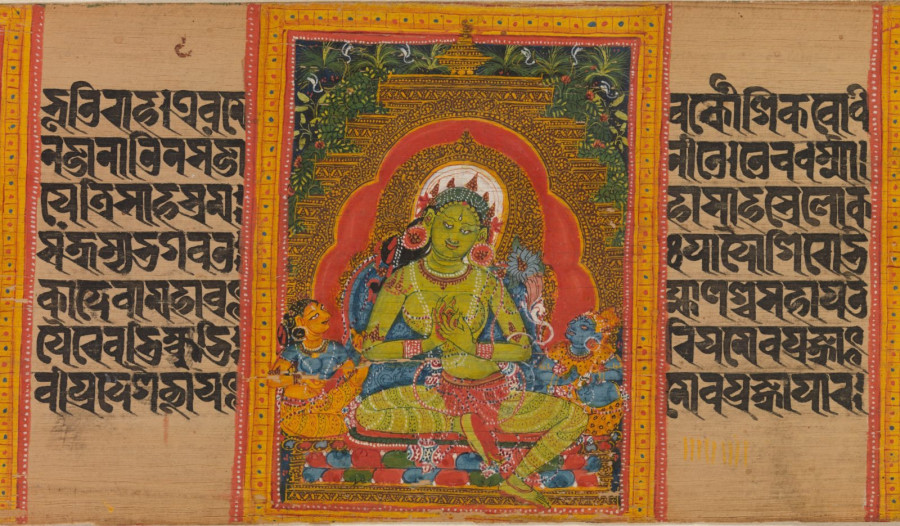Opinion
Perfection of art
A look at Nepal’s oldest illuminated manuscript at the Cambridge University Library
Sanyukta Shrestha
In the textbook titled Chitrakala (Painting) published by the Education Ministry for students of grades 9 and 10, the first mention under the history of Nepali art is of Astasahasrika Prajnaparamita dated 1015 AD. There is no accompanying image, and the textbook further claims that such manuscripts are preserved in Nepali museums. Min Bahadur Shakya’s pioneering work Sacred Art of Nepal dedicates a short paragraph and an unclear facsimile image from this same manuscript. This is all the information that Nepali students of art have about their oldest illustrated manuscript.
Arguably the most significant out of the 450 documents that Daniel Wright took back with him after serving as a surgeon at the British Residency in Kathmandu from 1866-76, this copy of Astasahasrika Prajnaparamita was purchased by the Cambridge University Library in 1876. Previous studies of Buddhist manuscripts like Prajnaparamita generally placed their textual content or the religious verses in main focus. Recently, I examined the manuscript with the aim of studying its polychrome illustrations based on primary sources.
Prajnaparamita for Bodhisattvas
In Sanskrit, Prajnaparamita means perfection of wisdom, and it is available in 500, 700, 2,500, 8,000, 18,000, 25,000 and 100,000 verses. The Astasahasrika version of Prajnaparamita has 8,000 verses, and it is considered to be the oldest format among all. As Mahayana Buddhism’s central concept, reading of Prajnaparamita is the essential path to becoming a Bodhisattva, which is the foundation of Buddhahood. Throughout the manuscript put together by the scribe Sujaata Bhadra in Lham Baha (believed to be in Patan or Kathmandu), it enumerates the features of a Bodhisattva as a journey that culminates in the teachings of the Buddha.
The manuscript exhibits a consistent rendition of rich illustrations outlined in red, and filled with blue, grey, yellow, green, white and red, in 42 out of its 222 folios. Excluding the seven deities painted on the inside of the front cover, there are a total of 85 illustrations out of which 27 are that of Loknath, around 21 of Buddha, and 11 of Green Tara. While other deities like Vajradhara, Kubera, Maitreya, Sahasrabhuja Loknath, Kurukulla, Maya Devi and White Tara are also featured in a few other illustrations, their hand gestures are generally either one from Vitaraka Mudra, Dharma Chakra Mudra, Varada Mudra, Abhaya Mudra or Bhumisparsha Mudra. The deities are seen sitting in 34 different illustrations in either Padmasana or Lalitasana, unless they are standing as is the case with the remaining 41 illustrations. Buddha is always depicted in a red robe and Loknath as a white body, which is typical of Nepali traditional art.
White chaityas and ornately decorated mahachaityas are a common theme in these illustrations, at least three folios (89th, 216th and 127th) depict multi-storeyed buildings too. Seeing such engineering achievements in a document that is more than a thousand years old not only proves the mettle of Newar architecture, but also adds to our confidence of dating historical edifices like Kasthamandap. Interestingly, most of the shrines are seen with a harmika, thus proving the dominance of Buddhist architecture in 11th-century Kathmandu Valley. Equally interesting is the mention of ‘Nepalye Swayambhu-nathah’ which attests the existence of the Swayambhu shrine in the Kathmandu Valley at least from that era or before.
Out of 28 illustrations including trees, the artist has offered a wide variety by depicting a single round, multiple rounds, inward/outward pointed, as well as wide-branched styles of trees. The knowledge of light and shade is quite evident in the paintings, but the natural rule of perspective is still missing. Some objects are impressively rendered in almost isometric view, but the top/plan views are far from accurate. Almost all illustrations are accompanied with captions in the Sanskrit language written in Nepal script. They help us identify Loknath, Buddha and Tara figures more accurately with the various different contexts in which they have been portrayed. References to geographical locations like Simhaladvipa and Gangaa Nadi also add to the context. Certain philosophical inferences can also be drawn from illustrations that depict two trees, but only the one with a female deity standing underneath it bears fruits on its branches. Such deep insights allow us to easily imagine the artistic standards of that time.
The palm leaf folios are very thin and fragile, and a hole is made in each folio to tie them all together with a string. Perhaps with a wish to make the tie-up as strong as a vajra, the artist has painted a vajra on each illuminated folio where a hole was later made. The colour of the pair of vajras on each illuminated folio is an almost alternating set of crimson and grey, and a random introduction of white, yellow and green ones in between the alterations.
Social belief
It is not hard to imagine what kind of belief system was prevalent in 11th-century Kathmandu Valley by simply looking at the terminologies used in the manuscript under consideration. Kubera is referred to as Jambhala, which is still common in Tibetan Buddhism. Even when a 1,000-handed Bodhisattva figure is being discussed, it is not labelled as Sahasrabhuja Avalokiteshwor. The Padmapani form of the lotus-holding Bodhisattva is labelled simply as Loknath and not Lokeshwor. The term Eeshwar is entirely absent from the 8,000 lines of text, and so is the term Devi. Even a female deity holding weapons with her 12 hands is not referred to as Devi anywhere in the text, but as a different portrayal of Tara, for example Bhagwati Tara; or Shakyamuni Buddha being referred to as Bhagwan.
The right degree of amalgamation of Buddhism and Hinduism from as early as the 11th century in the fertile land of the Kathmandu Valley has given form to the complex belief system of today’s Nepali society at large. This is also why it is impossible to understand art, cultural history and politics separately while they keep influencing each other more than anything else, be it then or now.
Shrestha is a researcher of Nepali history based out of London, UK.




 15.12°C Kathmandu
15.12°C Kathmandu











